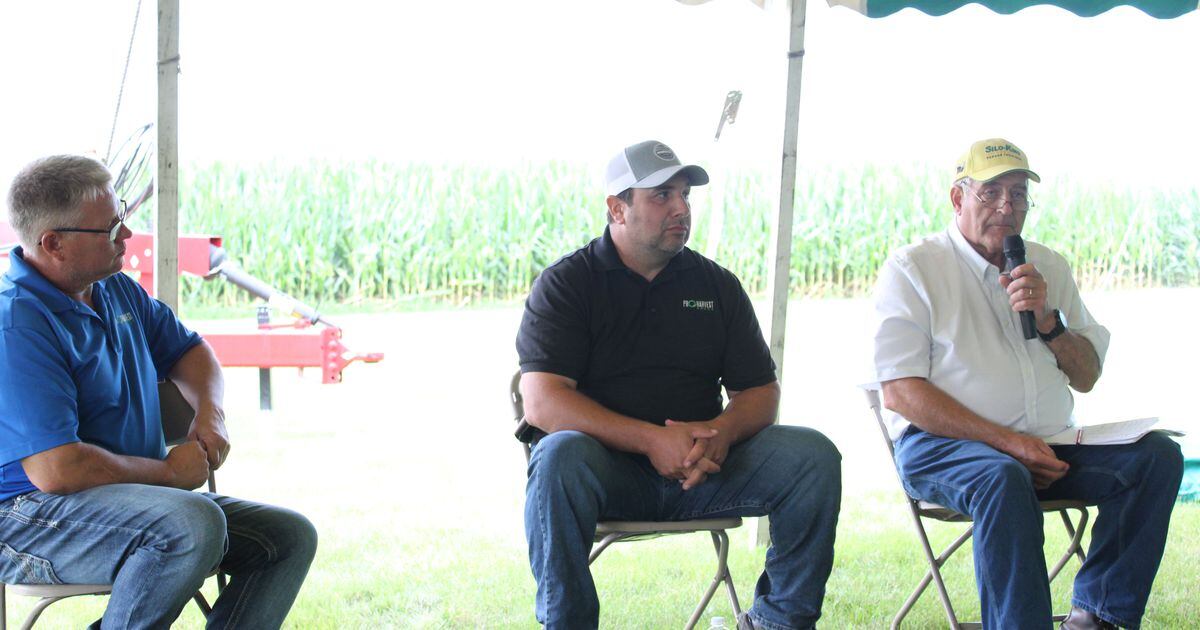
FAIRBURY, Ill. — Controlling alfalfa harvest is an important value of making baleage.
“Timing on alfalfa harvest has been the biggest thing by getting the first cutting off,” said John Kaeb, a custom hay harvester near Arrowsmith, Illinois. “We usually get four to five cuttings, so making baleage has helped keep us on time.”
Kaeb’s operation includes a 130-head cow herd and he feeds the baleage to his cattle and makes hay from the second, third and fourth cuttings to market to horse owners.
“We like to feed the baleage to our cows once they start calving,” he said during a panel discussion at the Forage Expo, sponsored by the Illinois Forage and Grassland Council. “The energy is there in the baleage, so you feed less.”
Kendall Guither has been making baleage on his operation for the past 25 years.
“I have up to 500 acres and most years I get six cuttings,” he said during the expo hosted by Kilgus Farmstead.
Guither sells all of his hay production and makes individual bales.
“I market hay to central Iowa, central Missouri, northern half of Illinois, Indiana, Wisconsin, Ohio and western Pennsylvania,” he said. “I have a mid-size baler that makes 3-by-3 bales, which is a size most skid loaders can handle.”
Kaeb prefers to make in-line wrapped bales.
“It works well for us because we’re keeping it on the farm,” he said. “And there is a savings in plastic.”
Doug Hanson manages a 60-cow herd and both in-line and individual baleage bales have been made from his hay fields.
“With an in-line wrapper, you want every bale to be identical, you don’t want it to look like doughnuts,” he said. “It should be smooth because that will give you the best fermentation on the bales and the highest quality hay.”
Guither rakes the alfalfa after it is cut to get a fast wilt down.
“I’m trying to stop plant respiration, which consumes feed value,” he said. “Rotary rakes are designed to handle a wet feed and they do a wonderful job.”
Basket rakes are not meant to handle a wet feed, Guither noted.
“Don’t use wheel rakes when doing a wet feed because they are ground driven, so you’ll get more ash,” he explained. “With that dirt you’ll get clostridia bacteria and the baleage environment is perfect for it to grow and it will ruin the bale of hay.”
The moisture of the bales needs to be from 40% to 60% to get food fermentation, Guither said.
“My dairy goat customers like it a little drier and for dairy and beef cows wetter is OK,” he said. “At 57% to 58% moisture, I’m hauling a little less water and the bales are a little easier to handle. Amish customers that feed it by hand prefer the bale moisture from 52% to 55%.”
Inoculants are important for baleage production to get the fermentation process done as quickly as possible.
“Some inoculants will have an antioxidant which helps get rid of the oxygen and a mold inhibitor to help prevent mold,” Guither said.
Preservatives and inoculants are two different products, he stressed.
“Preservatives are meant to kill bacteria and are used on dry hay,” he said. “Inoculants work on dry hay but really shine on baleage.”
Guither recommends wrapping baleage with eight layers of plastic to make sure there is a good seal on the bale.
“It is critical to get it sealed well,” he said. “If I wrap the bales in the field, I put on 10 layers because we’re going to handle the bales a couple of extra times.”
Quality of plastic is a huge factor, Guither said.
“If you can save $10 to $15 per roll of plastic, that will be 50 to 80 cents per bale and that’s the wrong time of the whole process to save 50 to 80 cents,” he noted. “You’ve got $50 to $80 worth of hay and you want to make sure it is going to keep.”
Kaeb uses a lighter color plastic for wrapping bales — white, light green or blue.
“A lighter color is better and I use white,” Guither said. “You don’t want heat getting through the plastic and causing a difference in the environment of the bale because of the extra heat generated by the sun.”
University testing has shown it is important to wrap bales within three to four hours after they are baled.
“The bale will start the fermenting process and generating heat four to five hours after baling,” Guither said. “That heat means bad bacteria is trying to grow, and if it has oxygen, it will consume some of the feed value of your forage.”
Baleage can be stored outside.
“Drainage is a big thing — make sure the water can get away,” Kaeb stressed.
Producers should also have rodent control around the bales.
“Mice love to burrow under the bales,” Guither said. “I put bait stations out and that does a good job of keeping the mice under control.”
For more information about the Illinois Forage and Grassland Council, go to www.illinoisforage.org.
"feed" - Google News
August 31, 2021 at 10:10PM
https://ift.tt/3gRrjLc
Making baleage keeps harvest timely, produces high-quality feed - Agri News
"feed" - Google News
https://ift.tt/2z3xEQN
https://ift.tt/2yko4c8
Bagikan Berita Ini














0 Response to "Making baleage keeps harvest timely, produces high-quality feed - Agri News"
Post a Comment